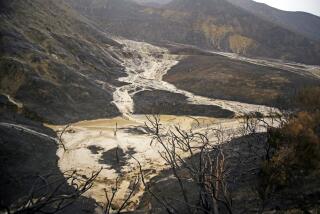It’s All Going Downhill : City Fears Loss of Cliffs, Beaches to Quick Erosion
HUNTINGTON BEACH — Troy Hohn, a surfer, was visibly concerned.
Standing recently on the eroding cliffs near Pacific Coast Highway, Hohn, 30, looked down on fallen earth and boulders. “Parts of the cliffs are falling off really big time now,” he said. “I hope something can be done about it.”
City officials likewise hope something can be done to save the imperiled cliffs along Pacific Coast Highway, between Bolsa Chica State Beach and Golden West Street. Once-slow erosion has rapidly increased this winter, hastened by rain and ocean storms battering the earthen bluffs. Huge chunks of soil have tumbled onto the narrow beach below the cliffs. The beach, in some areas, has virtually disappeared, covered by fallen rocks and mud.
The City Council last month unanimously passed a resolution urging the Army Corps of Engineers to perform a $250,000 study of the problems facing the bluffs. Louis F. Sandoval, the city’s public works director, said urgent action is needed.
“If something isn’t done soon, we’re not only going to lose part of the beach and the bluffs themselves, but we’re also going to lose Pacific Coast Highway,” Sandoval said. The strategic highway hugs the eroding bluffs between Bolsa Chica and downtown Huntington Beach.
The dun-colored bluffs form the northern entrance to Huntington Beach. Many people claim that the view is the most beautiful in the city. A new city open space, called Bluff Top Park, extends from 9th Street to Bolsa Chica State Beach. The landscaped park has paved bike and jogging trails, picnic tables and parking areas.
“Thousands of people come to these bluffs every week,” said Don Noble, a public works official in charge of coordinating action on the bluffs erosion. “Saving these bluffs is important to everyone in the state, not just the people of Huntington Beach.”
Noble said that “very rough estimates” by the city predict that the overall cost of stabilizing the cliffs will be $12 million or higher.
Most of coastal Huntington Beach is at sea level. But the bluffs, which extend for about a mile, make a dramatic difference in the city’s ocean vistas. “It’s a gorgeous view,” Sandoval said.
Until the mid-1980s the bluffs had an industrialized, tarnished look. Old oil wells and barren earth covered the narrow strip of high ground above the ocean. City government, working with the oil company, succeeded in getting the wells capped and closed. Then, using about $4 million in federal, state and county grants, the city built and landscaped the new Bluff Top Park over the newly cleared oil land.
On a recent sunny day, between rainstorms, scores of visitors walked, jogged or cycled through the bluffs area. In interviews, several said they thought that it was important for the erosion to be halted.
“It’s eroded quite a bit,” said Art Nehf, 37, as he stood on the bluffs. “Some of the cliffs have fallen away. These cliffs provide quite a bit of activity for the people of Huntington Beach and visitors. When you start losing these cliffs, you’ll be losing the bike paths and these other things here that make this such a nice attraction.”
Hohn, who said he surfs frequently around the bluffs area, said erosion has already destroyed part of the beaches below. Pointing to an area that is now covered by fallen boulders, Hohn said: “That used to be a very nice beach that the surfers called the Cove. It used to be a nice place to lie on the sand. Now it’s totally gone.”
The cliffs are about 30 feet high at their tallest point. Public works official Noble said the Bluff Top railings, built about five years ago, once were several feet from the edge of the cliffs. “Now some of the railings and the light poles are on the edge of the bluffs and are in danger of falling off,” Noble said.
There has always been ocean erosion at the cliffs because the sandy beach is narrow and the ocean frequently sweeps over the strand, Noble noted. He said the ground around the cliffs also has sunk, or subsided, slightly over the years because of the oil drilling from years past.
Sandoval said that before any work can be done, the Corps of Engineers needs to make a study of the problems, which he estimated would cost $250,000 and which would be entirely paid by the federal government. He said the next step would be a $100,000 analysis of potential solutions. Sandoval said the $100,000 cost would be shared by the city and the federal government.
City government three years ago made a plea to the Corps of Engineers for a federal study of the eroding bluffs. That request failed to get action.
Noble said the city has outlined the situation to the office of U.S. Rep. Dana Rohrabacher (R-Huntington Beach), who represents the area in Congress, for action on the federal study. Said Steve Kerekes, a spokesman for Rohrabacher, in a recent telephone interview from Washington: “The congressman is concerned about it (the erosion problem). He’s going to be meeting with Huntington Beach officials.”
In the meantime, worried nature lovers watch the cliffs with alarm and sadness as successive rainstorms slough off more of the land.
For surfers, such as Hohn, who have known the bluffs for years, the winter of ’93 is a tragic ecological turning point.
“This is the worst situation for the cliffs in years,” Hohn said.
More to Read
Sign up for Essential California
The most important California stories and recommendations in your inbox every morning.
You may occasionally receive promotional content from the Los Angeles Times.










